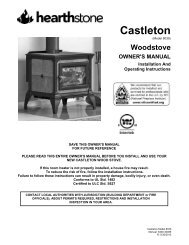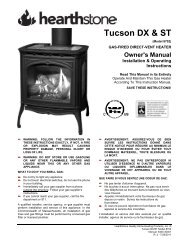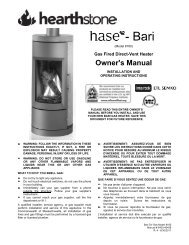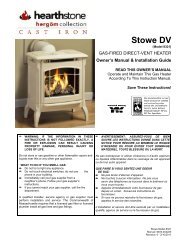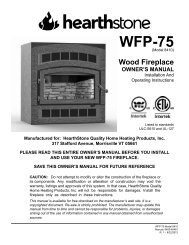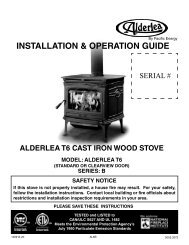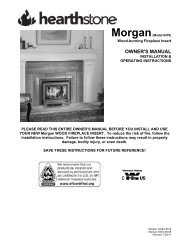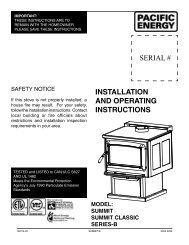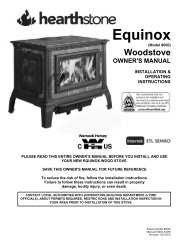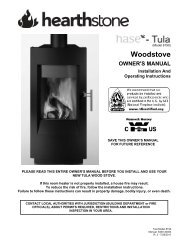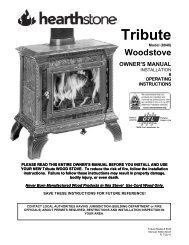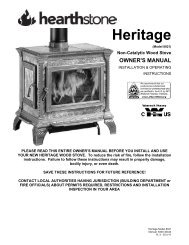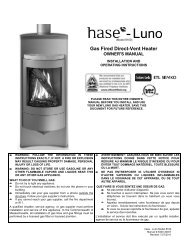Clydesdale 8491 Manual - Hearthstone Stoves
Clydesdale 8491 Manual - Hearthstone Stoves
Clydesdale 8491 Manual - Hearthstone Stoves
You also want an ePaper? Increase the reach of your titles
YUMPU automatically turns print PDFs into web optimized ePapers that Google loves.
<strong>Hearthstone</strong> <strong>Clydesdale</strong> Fireplace Insert Model <strong>8491</strong><br />
Remember, you must adhere to all previously<br />
described floor protection requirements when<br />
installing into a zero clearance fireplace.<br />
WARNING: DO NOT CONNECT THE FIREPLACE<br />
INSERT TO A CHIMNEY FLUE SERVING ANOTHER<br />
APPLIANCE.<br />
Ensure the size of the chimney’s flue is appropriate<br />
for the <strong>Clydesdale</strong>. The <strong>Clydesdale</strong> requires a 6"<br />
(152 mm) inside diameter flue for new installations.<br />
A 6” diameter flue provides adequate draft and<br />
performance. You can use an 8" (203 mm) diameter<br />
existing flue with a reducer. An oversized flue<br />
contributes to creosote accumulation. (In this case,<br />
bigger is NOT better.)<br />
There are two ways to install a prefabricated metal<br />
chimney:<br />
An interior installation where the chimney passes<br />
inside the residence through the ceiling and roof.<br />
An exterior installation where the chimney passes<br />
through the wall behind the Fireplace Insert then<br />
up the outside of the residence.<br />
Whenever possible, choose an interior chimney. An<br />
interior chimney heats quickly and retains its heat;<br />
thus promotes a better draft and discourages the<br />
formation of creosote. An exterior chimney does not<br />
benefit from the surrounding warmth of the building,<br />
so it typically operates at lower flue temperatures<br />
than an interior chimney. An exterior chimney’s draft<br />
is not as strong and may experience increased<br />
creosote accumulation.<br />
REMOVE THE DAMPER OR LOCK IT OPEN.<br />
Connection to a Masonry Chimney<br />
Hire a professional to examine the masonry chimney<br />
for cracks, loose mortar, and other signs of<br />
deterioration and blockage before connection. If the<br />
chimney needs repairs, complete them before<br />
installing and using your Fireplace Insert. Do not<br />
install your Fireplace Insert until the chimney is safe<br />
for use.<br />
Ensure the chimney’s cleanout is complete and<br />
working properly. To avoid a loss of draft, the<br />
cleanout must close off completely.<br />
Ensure the size of the chimney’s flue is appropriate<br />
for this Fireplace Insert and that it is not too large.<br />
Use a masonry chimney with a maximum 8" x 8" (203<br />
mm x 203 mm) tile size for best results. An oversized<br />
flue will contribute to the accumulation of creosote.<br />
Use the following checklist to ensure that your<br />
masonry chimney meets these minimum<br />
requirements:<br />
Chimney wall construction:<br />
A brick, modular block, rubble or stone wall at<br />
least 4" (102 mm) thick.<br />
Flue liner:<br />
Minimum ceramic flue liner thickness of 5/8" (16<br />
mm). Installed with refractory mortar and with at<br />
least 1" (25 mm) air space.<br />
An equivalent listed chimney flue liner system<br />
meeting type HT requirements or other approved<br />
material.<br />
Interior chimney requirements:<br />
At least 2" (51 mm) clearance to combustible<br />
structure<br />
Fire stops installed at the spaces where the<br />
chimney passes through floors and/or ceiling.<br />
Insulation must be 2" (51 mm) from the chimney.<br />
Exterior chimney requirements:<br />
At least 1" (25 mm) clearance to combustible<br />
structure.<br />
Chimney height requirements: (See page Error!<br />
Bookmark not defined.)<br />
At least 3 feet (0.9 m) higher than the highest<br />
part of the roof opening through which it passes.<br />
At least 2 feet (0.6 m) higher than any part of the<br />
roof within 10 feet (3 m) measured horizontally<br />
from the top of the chimney. This Fireplace<br />
Insert requires a minimum chimney height of 13<br />
feet (4 m). The maximum recommended<br />
chimney height is 30 feet (9m).<br />
IMPORTANT: You must seal the damper area<br />
around the chimney liner to prevent room air<br />
from entering the chimney cavity of the<br />
fireplace.<br />
WARNING: DO NOT REMOVE BRICKS OR<br />
MORTAR FROM THE EXISTING FIREPLACE!<br />
(Exception) Removal of masonry or steel (including<br />
the damper plate) from the smoke shelf and adjacent<br />
damper frame if necessary to accommodate a<br />
chimney liner, provided their removal will not weaken<br />
the structure of the fireplace and chimney, and will<br />
not reduce protection for clearance to combustible<br />
materials to less then required by the National<br />
Building Code.<br />
Page 18 of 33



